1. How can Yvan Christians products be purchased?
Our products are distributed through a dealer network in Belgium and abroad to limit transportation costs.
Our dealers can provide you with detailed information on our products.
Explicitly ask for sufficient product information and make sure to get our comprehensive Yvan Christiaens catalogue.
Our products are marked with a stamp:
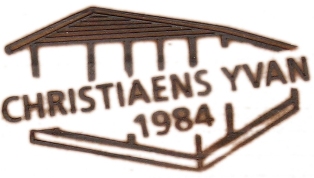
This stamp marks all our quality products. Please check the presence of the stamp upon delivery of your order. If you can’t find it, please inform us there of: info@tuinhuizenfabrikant.be.
2. How can I contact an Yvan Christiaens dealer?
Complete the information form and then we will send you our brochure with the contact data of the dealer in your area. This dealer knows all Yvan Christiaens products and can execute all works for you. He also provides an after-sales service.
3. Are the Yvan Christiaens products Belgian?
All Yvan Christiaens products are Belgian and are manufactured in our own workshop on a 25,000 m² site.
4. Are all Yvan Christiaens products displayed?
Because of the large range it is impossible to display all models. Therefore, ask for our brochure, it will largely inform you on all the possibilities.
5. Is custom-made work possible?
Of course, custom-made products can be made. Fax your plan to +32(0)56 77 47 52 and we will develop it.
6. What are the dimensions of windows and doors?
Windows and doors have standard dimensions. However, the customer can – within technical possibilities – choose the position. Doors can be delivered with or without glass (Yvan Christiaens products are only supplied with glass, no plastic windows!). There are various door types: modern or rustic. The sense of rotation can also be chosen. Rubber sealing is provided where possible. All of this without extra charges. Check the Yvan Christiaens for all the possibilities.
7. Does my garden house or carport have gutters?
Yes, all flat roofs with metal sheeting and/or EPDM foil have gutters. Gabled and pyramid roofs are not provided with gutters, but they are optional. For further information, contact your dealer.
8. What material are the posts made from?
The customer chooses the material for the posts: glued impregnated wood 12x12 or hardwood (extra charges). Oak is also an option at extra charge.
9. Is the garden house delivered exactly as shown in the pictures?
The pictures on our website and in our brochure were sent to us by our customers, and might have been taken some years ago. Also, the product might meanwhile have been adjusted due to product innovation. Some clients may have stained the wood, or optional gutters might have been mounted. Therefore, ask your dealer for the exact product description. The garden houses are supplied in accordance with these regulations.
10. What is the usual delivery term?
In general there is a delivery term of 4 working weeks for products without autoclave, 5 working weeks for products with autoclave and 6 working weeks or more for custom-made projects or (very) large garden houses. The delivery term is seasonal, from March to June the delivery term can be a few weeks longer.
12. Can I assembly the garden house myself?
Yes, you can easily assemble a 3x3 m garden house, if you are equipped with some tools, normally owned by a handyman. For larger garden houses and more complex constructions (such as annexes with awning or patio, EPDM roofing, etc.) we recommend assembly by an Yvan Christiaens professional or by one of his dealers.
13. What does the assembly cost?
The assembly costs depend on size, type, location and other factors. For further information, ask your dealer.
14. Does the building kit have an assembly plan?
Yes, every type is provided with a general assembly plan. It can however deviate from the supplied product, but the principle, the idea and the system remain the same. Because of our very large range and many types it is impossible to make a plan for every single type. If the assembly turns out to be a bit complex for you, we recommend to have the assembly done by our assembly service. Our professionals have experience, it is their job.
15. Is it best to provide a wooden or a concrete floor?
For a small garden house of approximately 3x3 m, a wooden floor might do. For larger garden houses, we recommend a concrete Floor. Yvan Christiaens or one of our dealers can also take care of that.
16. Which wood types are chosen for Yvan Christiaens products?
Cedar, whitewood, impregnated whitewood, oak, iroko and thermo ayous are available from stock. Other wood types can be chosen on demand.
18. What is panel construction?
Panel constructions are made from boards pre-mounted on a frame and screwed together in the corners. A corner profile finishes it off.
19. Which roofing is possible to combine with the Yvan Christiaens products?
Roofing made of shingles in various colours, fake tiles, metal sheet, EPDM foil, clay tiles and cedar slates.
20. Can I get an offer by e-mail or by phone?
It is best to visit your nearby dealer to discuss your wishes in detail. Complete the information file and we will send you the contact data of the dealer in your area.
21. Do I need a permit for my wooden shed?
Contact your local authorities and/or check http://www.ruimtelijkeordening.be.
22. Can you remove our old garden house?
Yes, we can remove your old garden house. Please contact your local dealer for further information and prices.
Important: An old garden house containing asbestos elements must be taken away by a licensed and specialised company.
23. Can you execute the concrete work?
Yes, if necessary we take care of all earthmoving and concrete work. Please contact your local dealer for more information and prices.
24. Can you provide our covered terrace with a wooden floor?
Yes, if you want, we can put wooden floor covering. Contact your dealer.
25. Can I buy doors, windows or loose parts from your company?
No, all parts are custom-made and for own production only. Loose parts cannot be supplied separately and are always part of a unit.
26. Can I paint my garden house?
Yes, but the paint must be damp controlling so the wood can still breathe. Autoclave-treated wooden garden houses must be left untreated for at least the first 3 years. Afterwards, they can be freshened up with garden oil! Garden houses made of cedar wood are best left untreated to weather naturally. You can and may treat them, but special oil adapted to cedar wood should be used!
27. Is it normal that the inner construction of my cedar garden house is made of whitewood?
Due to manufacturing and technical (solidity) reasons, the inner construction is always made of pinewood. The inner construction thus differs from the wood type chosen by the customer.
28. What material are the support beams and cornices made of?
Depending on the chosen wood type, the support beams and cornices are either made of the same wood type, or of an equivalent and equally durable wood type. Certain wood types (e.g. iroko) are not appropriate to be used for support beams or cornices.
29. Is your garden house ready for winter?
Winter is coming! Time to move all your outdoor furniture, garden tools and barbecue to the garden house. To make sure all of it is in a good condition after winter, we recommend to give your garden house a proper maintenance before the typical winter conditions really set in.
1. Remove moss from roof and gutters
The growth of moss on roofs and gutters is not abnormal. Nevertheless, removing it has both an aesthetic as a functional value. Rainwater no longer remains on the roof and in the gutters, so internal moisture has no chance. A simple and quick job that only requires a brush, and a mixture of water and bleach. Remove dead leaves and twigs from gutters to avoid obstructed drains. Your roof will look brand new.
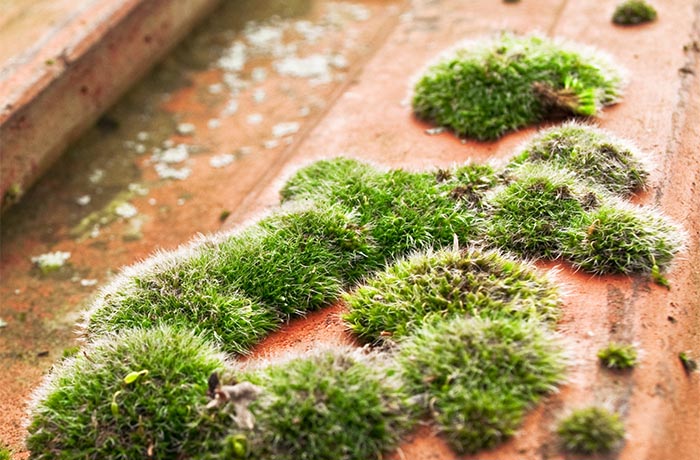
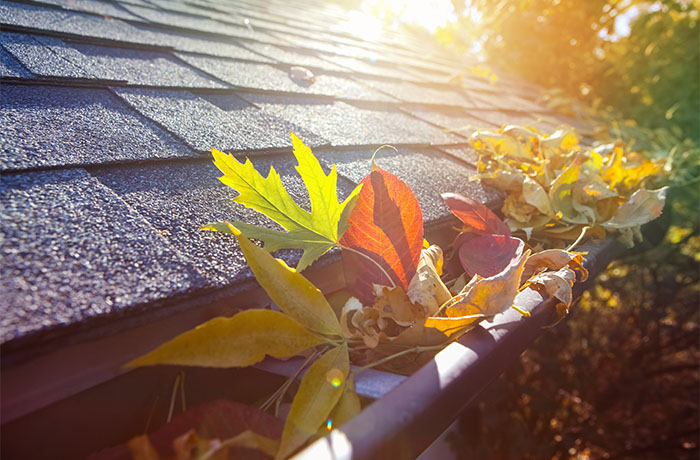
2. Check the roof sealing (EPDM roofing)
Water can enter your garden house through loose seams and poor roof sealing. To avoid problems, check your roof on the presence of cracks or other irregularities. Loose seams or cracks can be repaired with rubber tape. Bubbles must be cut open and repaired with rubber paste. Said repairing products can be purchased at DIY shops. If you don’t want to do it yourself, you can get help from a professional.

3. Lubricate lock and hinges
In general, garden house doors have three hinges. Use oil to lubricate the hinges as well as the rail of the sliding door, if any. Use a silicon spray to lubricate the lock bearings and the key itself. Next, turn the key to open and close the lock a couple of times to ensure a smooth performance.
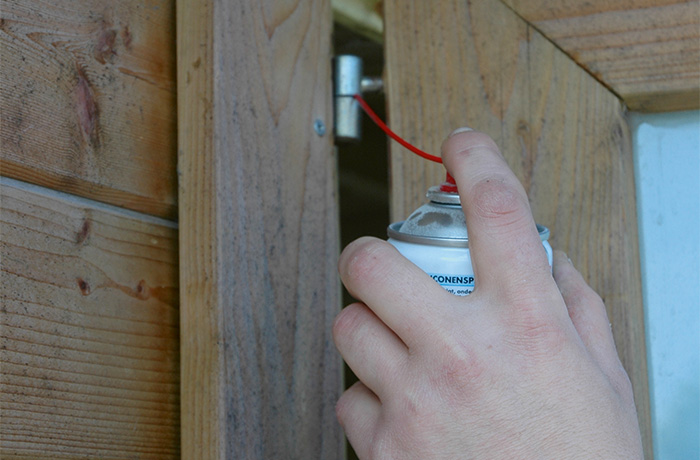
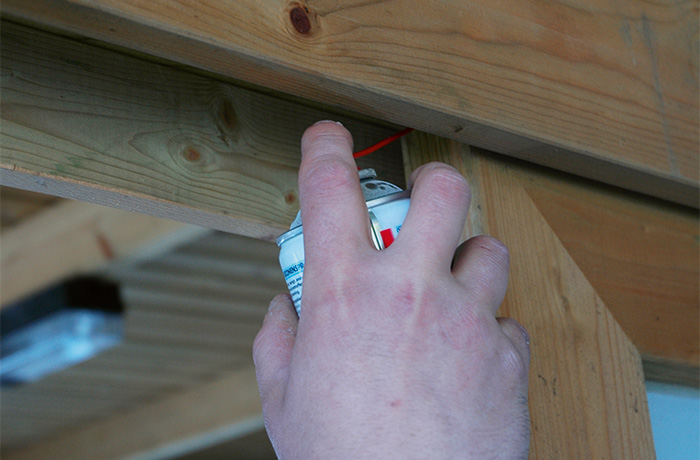
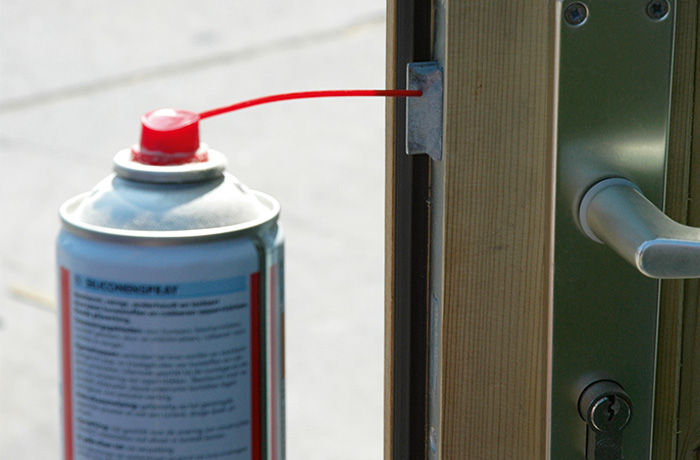
4. Apply stain to the wood
Recently installed garden houses must be treated inside and outside with coloured oil or stain for outdoor use. Never paint nor varnish the wood because it stops it from breathing and results in moisture accumulation.
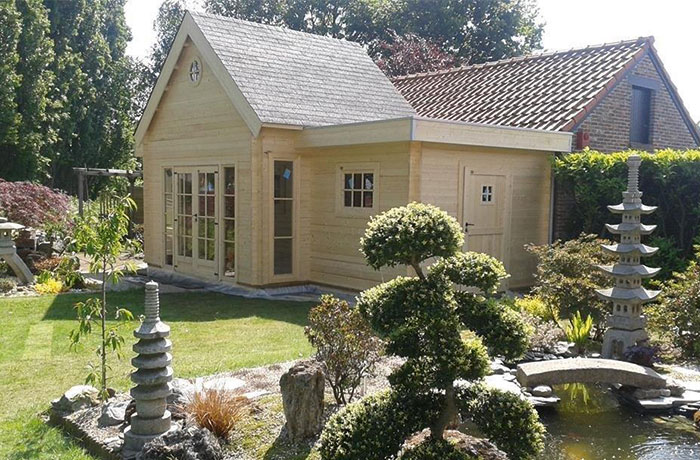
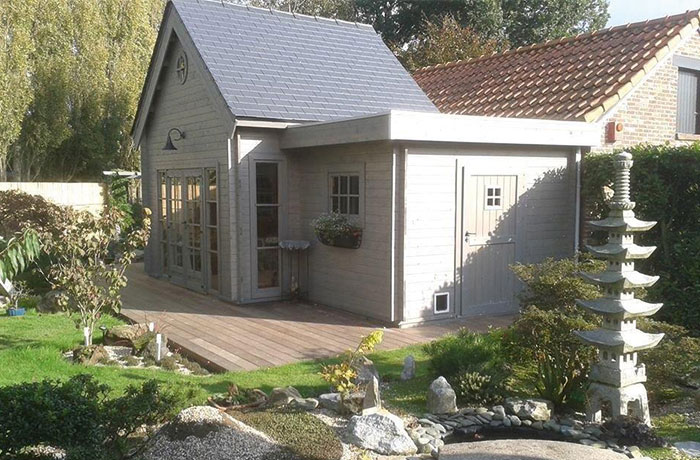
5. Proper venting
Good venting during winter times results in less condensation. Remember to regularly open the windows (tilt position or similar) or install an extra ventilation grid.
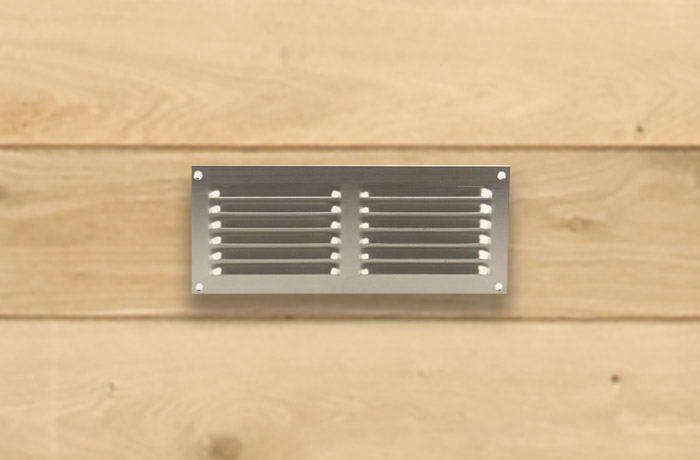
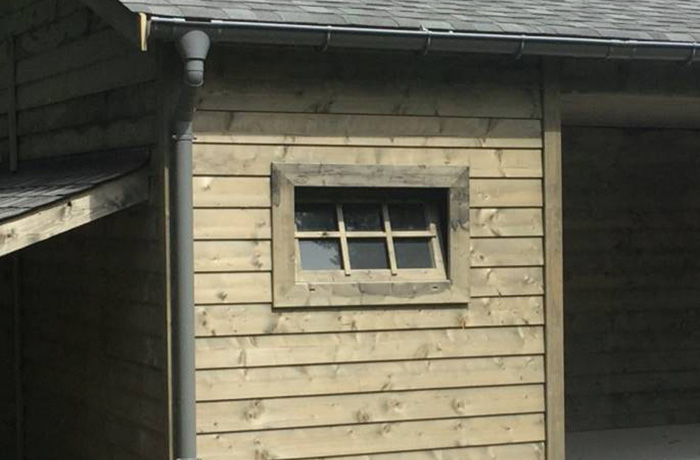
30. Can the concrete flooring be larger than my garden house?
No, the sizes are indicated and are always smaller than the volume of the garden house and at least 5 cm higher than the ground level. The same applies for additional terraces. However, they cannot be poured at the same level, they must be at least 5 cm lower!
31. How to avoid water splashing around your garden house?
By providing a gravel path (5 cm below the concrete slab) around the garden house, splashing water, soil or sand can be avoided. This lengthens the life of your garden house. Also read about maintenance.
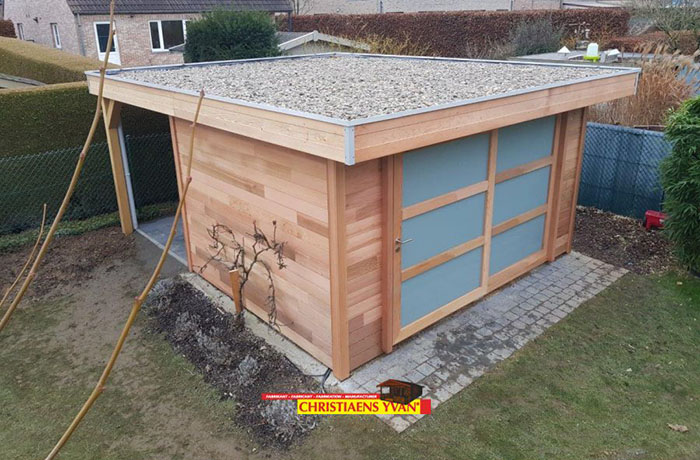
32. On the outside of my flat roof garden house, I see the metal plate that is used for the roofing. Is this normal?
Ceilings are only installed on the inside of garden houses, never on the outside. Therefore, it is absolutely normal to see the metal plate used for the roofing. Moreover, for reasons of rainwater discharge, the fascia board is never installed right against this metal plate
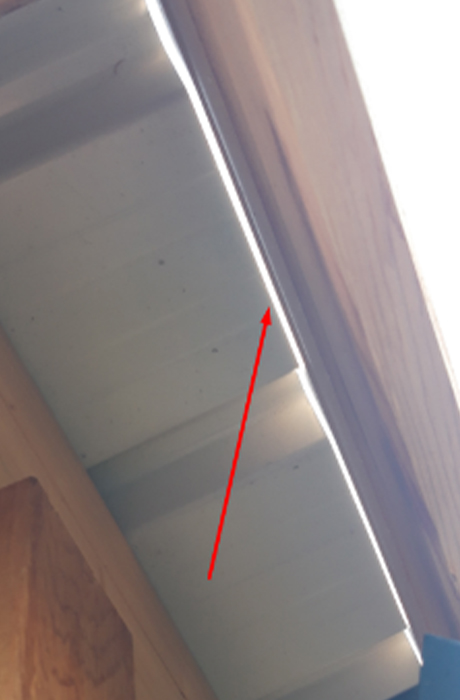
33. Should I check my garden house with a spirit level?
A garden house is a wooden construction and wood is a yearround living material. A garden house expands in winter and shrinks in summer. When assembling, we always aspire to obtain a great visual result. Therefore, it is kind of pointless to verify the construction with a spirit level after its assembly.
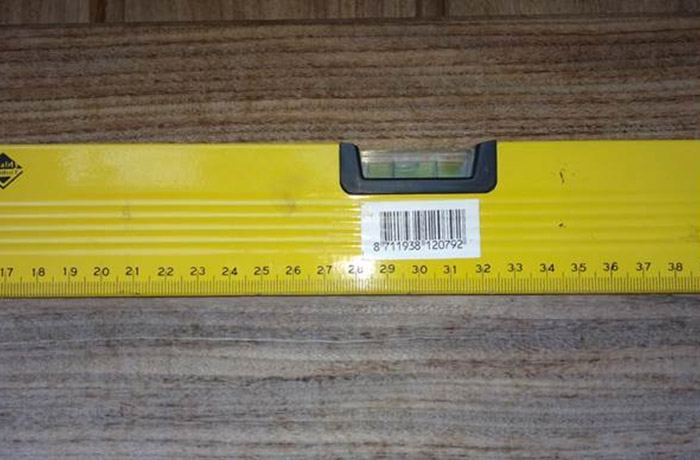
34. There’s a ventilation gap all around the bottom of my garden house. Is that normal?
Yes, garden houses with wooden floors must be ventilated to prevent mould and wood rot.
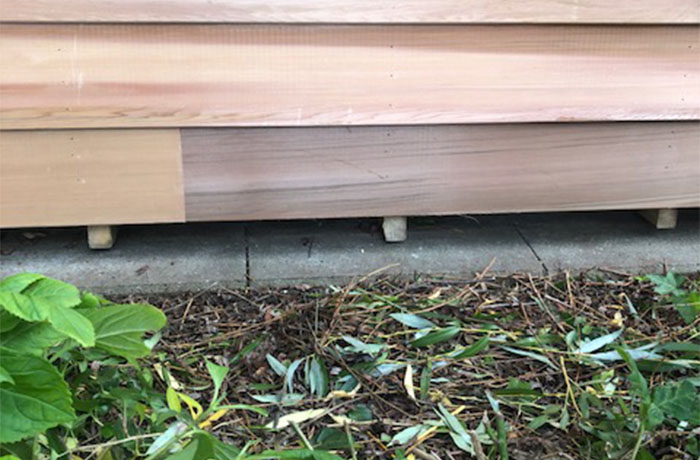
35. Is it okay to leave my non-assembled garden house in the garden for a longer period?
All panels of your garden house are supplied in a horizontal position on a pallet. All parts are wrapped in shrink foil. After delivery, it is advisable to place the wrapped panels upright in a place completely protected against sunshine and rainfall. We recommend not to wait for weeks or months to start assembling the garden house. Moreover, it is a bad idea to remove the panels’ packaging and to put them in your garden where they are exposed to the elements of nature. We strongly recommend to start as quickly as possible with the assembly of your garden house, followed by the roofing.
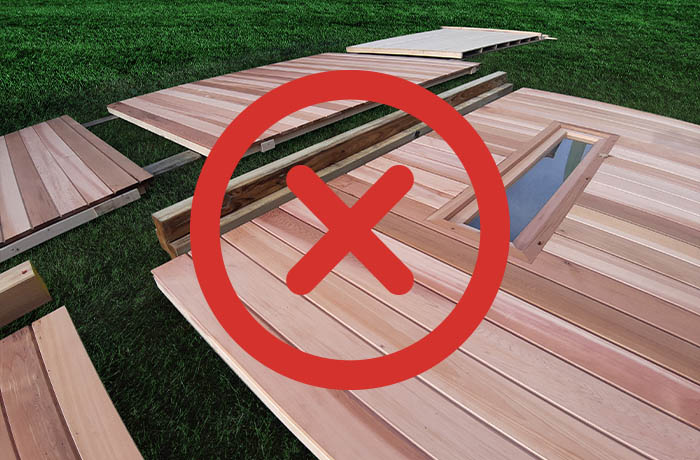
36. Is it normal that the post holder’s base is only partly fixed?
In the past, the wooden posts usually rested on stabilized sand. Afterwards, it became clear that the posts could sink so the garden house was no longer level after a while. For years now, we have been pouring concrete blocks in advance, right under the driveway or terrace ground level, so it can all be neatly concealed. The blocks only function as a fixed support during installation of the garden house. Even if the pole holder can only be partially screwed in, it absolutely does not affect the construction, nor the support.
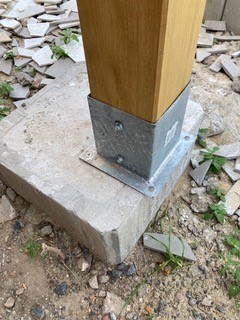
37. How to size the outlet tube for rainwater drainage?
Drainpipes for rainwater coming from the roof should at least have an 80 mm diameter, however 110 mm is better. After all, rainwater should be drained off easily to prevent water accumulation in the drainpipe and to avoid no or poor drainage. We recommend not to use an adapter to a smaller diameter.
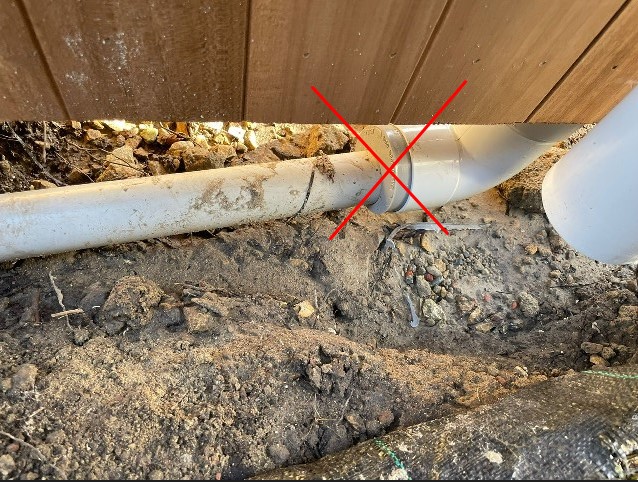
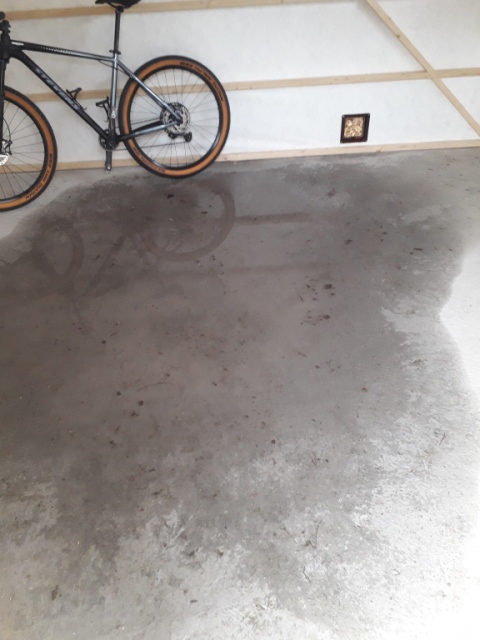
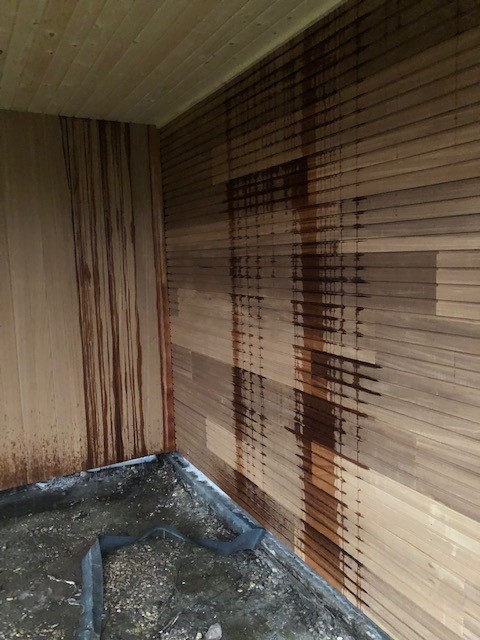
38. Mould on thermo ayous and other sustainable wood types: what to do?
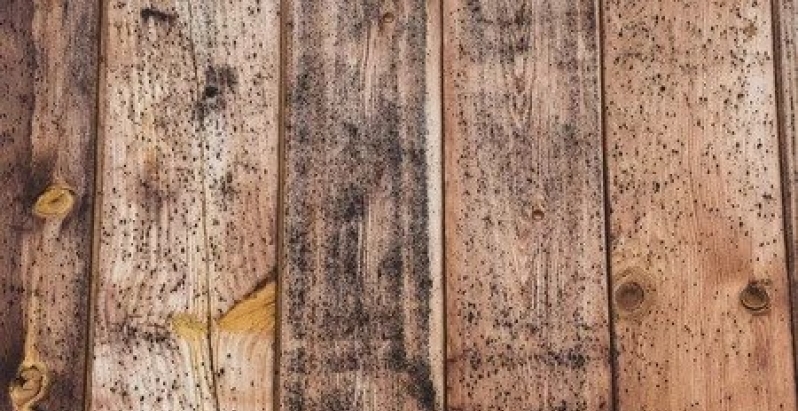
After days or even months of rain, everything in the garden is moist, including your garden house. A couple of months later you see black spots, stains and patches on your garden house made of thermo ayous wood. What is this? Mould on new material? No, this is not a manufacturing defect, nor it regards a bad board. On the contrary: moulding on wood is a natural process, even on wood types such as thermo ayous! But what should you do now? Is your wood damaged? This blog post examines this phenomenon and answers all of your questions.
It is very natural to find mould on wooden garden furniture as well as on wooden garden structures. All wood types, including European wood, tropical hardwood and thermally treated wood are susceptible to moulding by nature. Thermowood, however, is known for its resistance against mould which reduces the risk but still not fully excludes it.
Some positive news
No need to panic when you see mould on your wood. Here are some positive news facts!
First of all, mould is only hazardous for the material’s sustainability and firmness in exceptional cases. That is when the mould thrives on the wood and thus takes nutrients out of the material. Bacteria on thermally treated wood (such as thermo ayous) get their nutrients out of the air so they do not damage the wood. No mould will make the wood rot.
Even though you should not worry about the material’s firmness, there is an aesthetic difference: you do see black spots or patches on the boards. However, this discolouration disappears by itself: stains will disappear over time as the wood ages. How long does it take for the wood to have sufficiently aged and you no longer see spots? That depends on the situation and could take up to a year.
Would you like to get rid of these spots sooner than that? Here are some simple solutions you could implement to treat the surface nevertheless. Undiluted cleaning vinegar, for instance, can improve the mould in an aesthetical way. Or mix 50 to 100 grams of soda with a bucket of water and scrub the spots using a non-metallic brush. Leave the product on for a short time. The acid in the vinegar and the soda mix kills algae and mosses. Then rinse with clean water and the spots will disappear. You could also use an antifungal product.
Where does this mould come from?
Mould is often the result of moist in wood. This could come from rain, a drainpipe above the wood, leaking pipelines between boards or a pond that is in direct contact with the wood. The saying ‘prevention is better than cure’ also applies to wood. So make sure there is enough ventilation or that the wood is not in permanent contact with stagnant water. Leaking pipelines should be repaired as quickly as possible. Wood that is not in direct contact with water, or that can completely dry after being wet, is not that sensitive to moulding.
Sometimes moulding occurs on garden walls or on the outside of particular garden structures. Whether or not a project is susceptible to it, depends on its location and orientation. There is an increased risk of mould in shaded places. Also, south-west facing garden screens are more often exposed to rain. Covered pieces of wood that occasionally get wet, dry out more slowly which makes them perfect sources for mould to form on.
Moulding especially happens in wooded places where surface fungal often occurs. In such places fungal spores more often travel in the air after which they fall onto the wood and settle on it.
The susceptibility of wood to mould also depends on how it is dried at the manufacturer’s. After a tree is cut and sawn into boards, the wood is dried. Thermally treated wood is then heated in a kiln. Both processes largely decrease the wood’s moisture content. The less moist, the lower the risk of moulding. So if mould develops, it might be that the boards were taken out of the kiln too soon, or that they were not heated at a temperature high enough.
One last factor that can play a role in this, is the wood type. Lighter wood types, such as ayous, are more susceptible to mould than (tropical) hardwood types, such as ipe and padauk.
Conclusion
There are different reasons why mould might form on your thermally treated wood. So the most important thing to remember is that moulding is a natural process that you usually do not expect but could encounter. Even though thermally treated wood is less susceptible to moulding than other wood types, it is still possible to see black spots, stains and patches over time. After a while they will vanish in the aged grey colour of the wood. Mould will not affect the sustainability of your wooden garden wall, facade or terrace, so you do not need to worry about that. If you do want to get rid of it, you could clean the wood with for instance cleaning vinegar.
This article (originally in Dutch) was fully copied from Passie voor tuinen en wonen (Belgian website on gardens and living) - 01 sep 2022.


